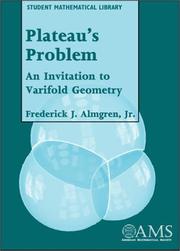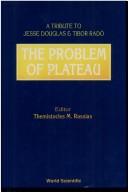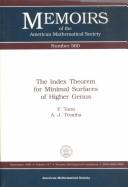| Listing 1 - 10 of 16 | << page >> |
Sort by
|

ISSN: 15209121 ISBN: 0821827472 9780821827475 Year: 2001 Volume: 13 Publisher: Providence (R.I.): American mathematical society,
Abstract | Keywords | Export | Availability | Bookmark
 Loading...
Loading...Choose an application
- Reference Manager
- EndNote
- RefWorks (Direct export to RefWorks)
Minimal surfaces. --- Plateau's problem. --- Differential topology. --- Differential topology --- Minimal surfaces --- Plateau's problem --- Minimal surface problem --- Plateau problem --- Problem of Plateau --- Surfaces, Minimal --- Maxima and minima --- Geometry, Differential --- Topology
Dissertation

Year: 2021 Publisher: Liège Université de Liège (ULiège)
Abstract | Keywords | Export | Availability | Bookmark
 Loading...
Loading...Choose an application
- Reference Manager
- EndNote
- RefWorks (Direct export to RefWorks)
Craniomaxillofacial surgery is the field of medical sciences that reconstructs the faces of patients who have had, for example, a car accident or bone cancer. This type of surgery mainly consists of the implantation of a graft to allow the rehabilitation and restoration of the shape and the function of the injured bone region. The current treatments, such as autografts, allografts or alloplastic grafts, present some disadvantages that can have severe consequences for the patient. Cerhum, a company focused on ceramic 3D printing, proposes an implant that overcomes some of these disadvantages: a 3D printed bioceramic bone graft. The ceramic used, which is mainly composed of hydroxyapatite, allows excellent biocompatibility. In addition to its supporting role, the microstructure must have a geometry that guides and stimulates bone regeneration in the implant. The main aim of this research work is to study in silico the influence of different microstructures on the mechanical support performance of the implant. In order to fulfil their role as a guide and stimulus for the bone regeneration process, the microstructures must exhibit several geometrical characteristics, such as a pronounced tortuosity. The different architectures selected are Orthogonal unit cells, TPMS (Triply Periodic Minimal Surface) unit cells (Primitive, Gyroid and Diamond) and Isometric TPMS unit cells (Isometric Gyroid and Isometric Diamond). These microstructures are numerically modelled in scaffolds with four cell repetitions in all three directions. For a given architecture, several scaffolds are built with different porosity percentages. Finite Element (FE) analysis in compression, under the assumption of a quasi-static state, are performed on these models. From this FE analysis, Young's moduli in compression of the different structures are compared. The two main characteristics affecting the elastic mechanical performance of a structure are its architecture and its porosity rate. Young's modulus decreases when the porosity rate increases. The results of this research work suggest that, in the 35-85\% porosity range, Diamond cells present a higher elastic modulus than Orthogonal and other TPMS structures. However, Gyroid scaffolds have Young's moduli in the same order as the bone, unlike Primitive and Diamond. Regarding structures made of Isometric TPMS cells, Diamond and Isometric Diamond have similar Young's moduli in compression. While Isometric Gyroid cells offer higher elastic strength than Gyroid cells. The second part of this research work focuses on scaffolds made of Primitive, Gyroid and Diamond cells including a porosity gradient within the structure. Indeed, as in natural bone, the implant shell is made of a compact structure, i.e. with low porosity, while the interior is spongy, i.e. with higher porosity. The region linking them present a porosity gradient. This study suggests that inserting a porosity gradient weakens the structures. Moreover, regarding the Young's modulus, the sensitivity to porosity gradient is less significant for Gyroid cells than Diamond and Primitive cells. In conclusion, microstructures made of Gyroid cells are the more interesting. Their Young's moduli are matching the native bone one which leads to better implant osseointegration. Their high mechanical resistance remains when explored to porosity gradients.
Graft --- Implant --- Bioceramics --- Microstructure --- Triply Periodic Minimal Surface (TPMS) --- Porosity gradient --- Scaffold --- In silico study --- Young's modulus --- Modelling --- Compression simulation --- Finite element analysis --- Ingénierie, informatique & technologie > Multidisciplinaire, généralités & autres

ISBN: 9810205562 9789810205560 Year: 1992 Publisher: Singapore : World scientific,
Abstract | Keywords | Export | Availability | Bookmark
 Loading...
Loading...Choose an application
- Reference Manager
- EndNote
- RefWorks (Direct export to RefWorks)
Oppervlakken [Minimale ] --- Plateau [Problème de ] --- Plateau's problem --- Probleem van Plateau --- Surfaces [Minimal ] --- Surfaces minimales --- Minimal surfaces --- Plateau, problème de --- Douglas, Jesse, --- Plateau, Joseph, --- Radó, Tibor, --- Plateau's problem. --- Minimal surfaces. --- Surfaces, Minimal --- Maxima and minima --- Minimal surface problem --- Plateau problem --- Problem of Plateau --- Radó, T. --- Radó, Tibor, --- Plateau, problème de

ISSN: 00659266 ISBN: 0821803522 Year: 1995 Publisher: Providence, RI. : American Mathematical Society,
Abstract | Keywords | Export | Availability | Bookmark
 Loading...
Loading...Choose an application
- Reference Manager
- EndNote
- RefWorks (Direct export to RefWorks)
Minimal surfaces. --- Plateau's problem. --- Index theorems. --- Surfaces minimales --- Plateau, problème de --- Plateau, problème de --- Surfaces minimales. --- Plateau, Problème de. --- Théorèmes d'indices. --- Index theorems --- Minimal surfaces --- Plateau's problem --- Minimal surface problem --- Plateau problem --- Problem of Plateau --- Surfaces, Minimal --- Maxima and minima --- Differential operators --- Global analysis (Mathematics) --- Index theory (Mathematics) --- Manifolds (Mathematics)
Book
Year: 2022 Publisher: Basel MDPI - Multidisciplinary Digital Publishing Institute
Abstract | Keywords | Export | Availability | Bookmark
 Loading...
Loading...Choose an application
- Reference Manager
- EndNote
- RefWorks (Direct export to RefWorks)
Additive manufacturing (AM), more commonly known as 3D printing, has grown trememdously in recent years. It has shown its potential uses in the medical, automotive, aerospace, and spare part sectors. Personal manufacturing, complex and optimized parts, short series manufacturing, and local on-demand manufacturing are just some of its current benefits. The development of new materials and equipment has opened up new application possibilities, and equipment is quicker and cheaper to use when utilizing the new materials launched by vendors and material developers. AM has become more critical for the industry but also for academics. Since AM offers more design freedom than any other manufacturing process, it provides designers with the challenge of designing better and more efficient products.
Technology: general issues --- History of engineering & technology --- additive manufacturing --- modular design --- design-for-manufacturability --- design optimization --- part consolidation --- product re-design --- topology optimization --- design for additive manufacturing --- 3D printing --- aerospace --- full-life cycle manufacturing flow --- airfoil --- carbon fiber tubes --- telescoping spars --- chevrons --- porous scaffold design --- tetrahedral implicit surface modeling --- triply periodic minimal surface --- selective laser melting (SLM) --- Ti6Al4V --- structure–property relationship --- microstructure --- Hall–Petch relationship --- n/a --- structure-property relationship --- Hall-Petch relationship
Book
Year: 2022 Publisher: Basel MDPI - Multidisciplinary Digital Publishing Institute
Abstract | Keywords | Export | Availability | Bookmark
 Loading...
Loading...Choose an application
- Reference Manager
- EndNote
- RefWorks (Direct export to RefWorks)
Additive manufacturing (AM), more commonly known as 3D printing, has grown trememdously in recent years. It has shown its potential uses in the medical, automotive, aerospace, and spare part sectors. Personal manufacturing, complex and optimized parts, short series manufacturing, and local on-demand manufacturing are just some of its current benefits. The development of new materials and equipment has opened up new application possibilities, and equipment is quicker and cheaper to use when utilizing the new materials launched by vendors and material developers. AM has become more critical for the industry but also for academics. Since AM offers more design freedom than any other manufacturing process, it provides designers with the challenge of designing better and more efficient products.
additive manufacturing --- modular design --- design-for-manufacturability --- design optimization --- part consolidation --- product re-design --- topology optimization --- design for additive manufacturing --- 3D printing --- aerospace --- full-life cycle manufacturing flow --- airfoil --- carbon fiber tubes --- telescoping spars --- chevrons --- porous scaffold design --- tetrahedral implicit surface modeling --- triply periodic minimal surface --- selective laser melting (SLM) --- Ti6Al4V --- structure–property relationship --- microstructure --- Hall–Petch relationship --- n/a --- structure-property relationship --- Hall-Petch relationship
Book
Year: 2022 Publisher: Basel MDPI - Multidisciplinary Digital Publishing Institute
Abstract | Keywords | Export | Availability | Bookmark
 Loading...
Loading...Choose an application
- Reference Manager
- EndNote
- RefWorks (Direct export to RefWorks)
Additive manufacturing (AM), more commonly known as 3D printing, has grown trememdously in recent years. It has shown its potential uses in the medical, automotive, aerospace, and spare part sectors. Personal manufacturing, complex and optimized parts, short series manufacturing, and local on-demand manufacturing are just some of its current benefits. The development of new materials and equipment has opened up new application possibilities, and equipment is quicker and cheaper to use when utilizing the new materials launched by vendors and material developers. AM has become more critical for the industry but also for academics. Since AM offers more design freedom than any other manufacturing process, it provides designers with the challenge of designing better and more efficient products.
Technology: general issues --- History of engineering & technology --- additive manufacturing --- modular design --- design-for-manufacturability --- design optimization --- part consolidation --- product re-design --- topology optimization --- design for additive manufacturing --- 3D printing --- aerospace --- full-life cycle manufacturing flow --- airfoil --- carbon fiber tubes --- telescoping spars --- chevrons --- porous scaffold design --- tetrahedral implicit surface modeling --- triply periodic minimal surface --- selective laser melting (SLM) --- Ti6Al4V --- structure-property relationship --- microstructure --- Hall-Petch relationship
Book
ISBN: 3039217313 3039217305 9783039217311 Year: 2019 Publisher: Basel, Switzerland : MDPI,
Abstract | Keywords | Export | Availability | Bookmark
 Loading...
Loading...Choose an application
- Reference Manager
- EndNote
- RefWorks (Direct export to RefWorks)
Although scientific computing is very often associated with numeric computations, the use of computer algebra methods in scientific computing has obtained considerable attention in the last two decades. Computer algebra methods are especially suitable for parametric analysis of the key properties of systems arising in scientific computing. The expression-based computational answers generally provided by these methods are very appealing as they directly relate properties to parameters and speed up testing and tuning of mathematical models through all their possible behaviors. This book contains 8 original research articles dealing with a broad range of topics, ranging from algorithms, data structures, and implementation techniques for high-performance sparse multivariate polynomial arithmetic over the integers and rational numbers over methods for certifying the isolated zeros of polynomial systems to computer algebra problems in quantum computing.
superposition --- SU(2) --- pseudo-remainder --- interval methods --- sparse polynomials --- element order --- Henneberg-type minimal surface --- timelike axis --- combinatorial decompositions --- sparse data structures --- mutually unbiased bases --- invariant surfaces --- projective special unitary group --- Minkowski 4-space --- free resolutions --- Dini-type helicoidal hypersurface --- linearity --- integrability --- Galois rings --- minimum point --- entanglement --- degree --- pseudo-division --- computational algebra --- polynomial arithmetic --- projective special linear group --- normal form --- Galois fields --- Gauss map --- implicit equation --- number of elements of the same order --- Weierstrass representation --- Lotka–Volterra system --- isolated zeros --- polynomial modules --- over-determined polynomial system --- simple Kn-group --- sum of squares --- four-dimensional space
Book
ISBN: 0691085102 0691607753 1400860210 Year: 1988 Publisher: Princeton (N.J.) : Princeton university press,
Abstract | Keywords | Export | Availability | Bookmark
 Loading...
Loading...Choose an application
- Reference Manager
- EndNote
- RefWorks (Direct export to RefWorks)
This book is meant to give an account of recent developments in the theory of Plateau's problem for parametric minimal surfaces and surfaces of prescribed constant mean curvature ("H-surfaces") and its analytical framework. A comprehensive overview of the classical existence and regularity theory for disc-type minimal and H-surfaces is given and recent advances toward general structure theorems concerning the existence of multiple solutions are explored in full detail.The book focuses on the author's derivation of the Morse-inequalities and in particular the mountain-pass-lemma of Morse-Tompkins and Shiffman for minimal surfaces and the proof of the existence of large (unstable) H-surfaces (Rellich's conjecture) due to Brezis-Coron, Steffen, and the author. Many related results are covered as well. More than the geometric aspects of Plateau's problem (which have been exhaustively covered elsewhere), the author stresses the analytic side. The emphasis lies on the variational method.Originally published in 1989.The Princeton Legacy Library uses the latest print-on-demand technology to again make available previously out-of-print books from the distinguished backlist of Princeton University Press. These editions preserve the original texts of these important books while presenting them in durable paperback and hardcover editions. The goal of the Princeton Legacy Library is to vastly increase access to the rich scholarly heritage found in the thousands of books published by Princeton University Press since its founding in 1905.
Calculus of variations. --- Global analysis (Mathematics). --- Minimal surfaces. --- Plateau's problem. --- Global analysis (Mathematics) --- MATHEMATICS / Geometry / Differential. --- Analysis, Global (Mathematics) --- Differential topology --- Functions of complex variables --- Geometry, Algebraic --- Isoperimetrical problems --- Variations, Calculus of --- Maxima and minima --- Minimal surface problem --- Plateau problem --- Problem of Plateau --- Minimal surfaces --- Surfaces, Minimal --- Banach space. --- Bernhard Riemann. --- Big O notation. --- Boundary value problem. --- Branch point. --- C0. --- Closed geodesic. --- Compact space. --- Complex analysis. --- Complex number. --- Conformal map. --- Conjecture. --- Contradiction. --- Convex curve. --- Convex set. --- Differentiable function. --- Direct method in the calculus of variations. --- Dirichlet integral. --- Dirichlet problem. --- Embedding. --- Estimation. --- Euler–Lagrange equation. --- Existential quantification. --- Geometric measure theory. --- Global analysis. --- Jordan curve theorem. --- Linear differential equation. --- Mathematical analysis. --- Mathematical problem. --- Mathematician. --- Maximum principle. --- Mean curvature. --- Metric space. --- Minimal surface. --- Modulus of continuity. --- Morse theory. --- Nonparametric statistics. --- Normal (geometry). --- Parallel projection. --- Parameter space. --- Parametrization. --- Partial differential equation. --- Quadratic growth. --- Quantity. --- Riemann mapping theorem. --- Second derivative. --- Sign (mathematics). --- Special case. --- Surface area. --- Tangent space. --- Theorem. --- Total curvature. --- Uniform convergence. --- Variational method (quantum mechanics). --- Variational principle. --- W0. --- Weak solution.
Book
ISBN: 0691615004 0691642575 1400856450 9781400856459 0691082901 9780691082905 9780691615004 9780691615004 9780691642574 Year: 1981 Publisher: Princeton, N.J. [Tokyo] Princeton University Press University of Tokyo Press
Abstract | Keywords | Export | Availability | Bookmark
 Loading...
Loading...Choose an application
- Reference Manager
- EndNote
- RefWorks (Direct export to RefWorks)
Mathematical No/ex, 27Originally published in 1981.The Princeton Legacy Library uses the latest print-on-demand technology to again make available previously out-of-print books from the distinguished backlist of Princeton University Press. These editions preserve the original texts of these important books while presenting them in durable paperback and hardcover editions. The goal of the Princeton Legacy Library is to vastly increase access to the rich scholarly heritage found in the thousands of books published by Princeton University Press since its founding in 1905.
Riemannian manifolds. --- Minimal surfaces. --- Surfaces, Minimal --- Maxima and minima --- Manifolds, Riemannian --- Riemannian space --- Space, Riemannian --- Geometry, Differential --- Manifolds (Mathematics) --- Differential geometry. Global analysis --- Addition. --- Analytic function. --- Branch point. --- Calculation. --- Cartesian coordinate system. --- Closed geodesic. --- Codimension. --- Coefficient. --- Compactness theorem. --- Compass-and-straightedge construction. --- Continuous function. --- Corollary. --- Counterexample. --- Covering space. --- Curvature. --- Curve. --- Decomposition theorem. --- Derivative. --- Differentiable manifold. --- Differential geometry. --- Disjoint union. --- Equation. --- Essential singularity. --- Estimation. --- Euclidean space. --- Existence theorem. --- Existential quantification. --- First variation. --- Flat topology. --- Fundamental group. --- Geometric measure theory. --- Great circle. --- Homology (mathematics). --- Homotopy group. --- Homotopy. --- Hyperbolic function. --- Hypersurface. --- Integer. --- Line–line intersection. --- Manifold. --- Measure (mathematics). --- Minimal surface. --- Monograph. --- Natural number. --- Open set. --- Parameter. --- Partition of unity. --- Pointwise. --- Quantity. --- Regularity theorem. --- Riemann surface. --- Riemannian manifold. --- Scalar curvature. --- Scientific notation. --- Second fundamental form. --- Sectional curvature. --- Sequence. --- Sign (mathematics). --- Simply connected space. --- Smoothness. --- Sobolev inequality. --- Solid torus. --- Subgroup. --- Submanifold. --- Summation. --- Theorem. --- Topology. --- Two-dimensional space. --- Unit sphere. --- Upper and lower bounds. --- Varifold. --- Weak topology.
| Listing 1 - 10 of 16 | << page >> |
Sort by
|

 Search
Search Feedback
Feedback About UniCat
About UniCat  Help
Help News
News